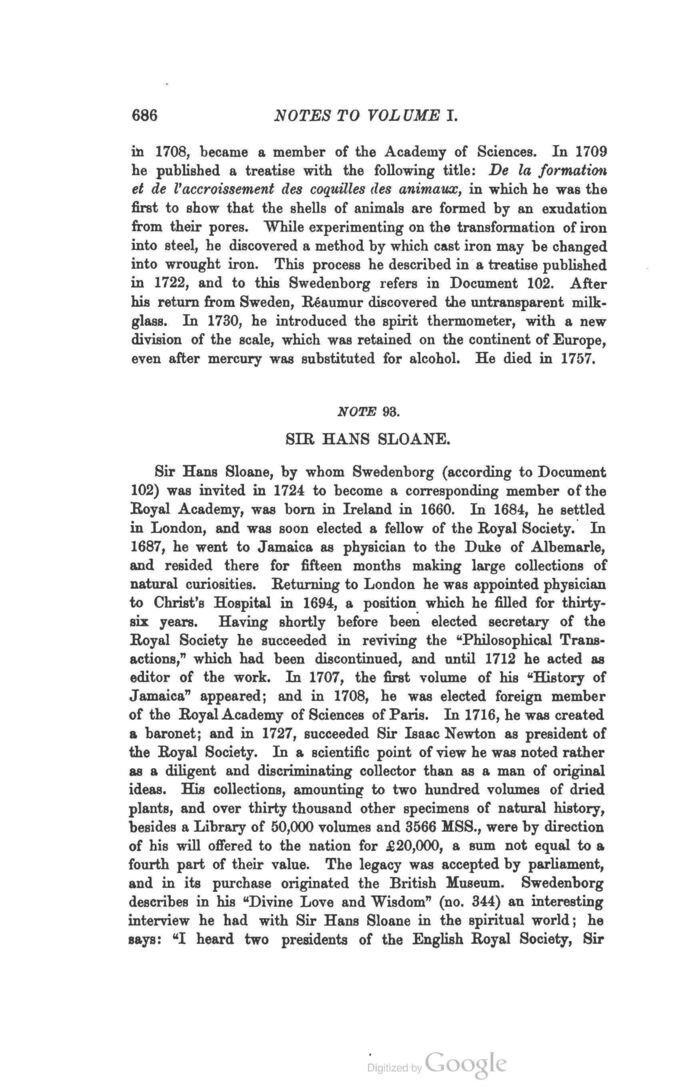
Full resolution (JPEG) - On this page / på denna sida - Sidor ...

<< prev. page << föreg. sida << >> nästa sida >> next page >>
Below is the raw OCR text
from the above scanned image.
Do you see an error? Proofread the page now!
Här nedan syns maskintolkade texten från faksimilbilden ovan.
Ser du något fel? Korrekturläs sidan nu!
This page has never been proofread. / Denna sida har aldrig korrekturlästs.
686 NOTES TO VOLUME I.
a
in 1708, became a member of the Academy of Sciences. In 1709
he published a treatise with the following title: De la formation
et de l’accroissement des coquilles les animaux, in which he was the
first to show that the shells of animals are formed by an exudation
from their pores. While experimenting on the transformation of iron
into steel, he discovered a method by which cast iron may be changed
into wrought iron. This process he described in a treatise published
in 1722, and to this Swedenborg refers in Document 102. After
his return from Sweden, Réaumur discovered the untransparent milk
glass. In 1730, he introduced the spirit thermometer, with a new
division of the scale, which was retained on the continent of Europe,
even after mercury was substituted for alcohol. He died in 1757.
NOTE 93.
SIR HANS SLOANE.
six years.
Sir Hans Sloane, by whom Swedenborg (according to Document
102) was invited in 1724 to become a corresponding member of the
Royal Academy, was born in Ireland in 1660. In 1684, he settled
in London, and was soon elected a fellow of the Royal Society. In
1687, he went to Jamaica as physician to the Duke of Albemarle,
and resided there for fifteen months making large collections of
natural curiosities. Returning to London he was appointed physician
to Christ’s Hospital in 1694, a position which he filled for thirty
Having shortly before been elected secretary of the
Royal Society he succeeded in reviving the “ Philosophical Trans
actions,” which had been discontinued, and until 1712 he acted as
editor of the work. In 1707, the first volume of his “ History of
Jamaica " appeared ; and in 1708, he was elected foreign member
of the Royal Academy of Sciences of Paris. In 1716, he was created
a baronet; and in 1727, succeeded Sir Isaac Newton as president of
the Royal Society. In a scientific point of view he was noted rather
as a diligent and discriminating collector than as a man of original
ideas. His collections, amounting to two hundred volumes of dried
plants, and over thirty thousand other specimens of natural history,
besides a Library of 50,000 volumes and 3566 MSS., were by direction
of his will offered to the nation for £ 20,000, a sum not equal to a
fourth part of their value. The legacy was accepted by parliament,
and in its purchase originated the British Museum. Swedenborg
describes in his “ Divine Love and Wisdom” (no. 344) an interesting
interview he had with Sir Hans Sloane in the spiritual world; he
says: “I heard two presidents of the English Royal Society, Sir
<< prev. page << föreg. sida << >> nästa sida >> next page >>